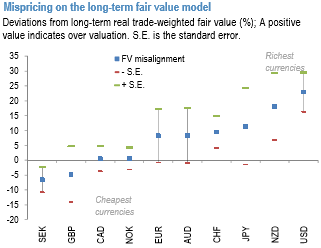AUDUSD remains in the middle of the USD 0.72 - 0.78 range that has held since mid-2016. The upside for the currency is indeed capped by the prospect of further narrowing in short rate spreads and a sense that the Australian economy is not performing as strongly as policy makers would probably like.
However, a move below USD0.72 in the near-term would require further escalation of China growth concerns and/or commodity weakness and a sense that the RBA has sufficient flexibility on the housing front to ease. As a result, AUDUSD is projected to decline further through 2017 on skinnier rate differentials and weaker terms of trade profile.
GBP has been in focus and has been the underperformer in G10 since our last publication in the run-up to the elections. The ranking hasn’t changed since our last publication, even though the dollar has continued to slide to make a new 6-month low on a TWI basis. Aussie and Kiwi dollar have still been the richest currencies, while SEK and GBP are still the weakest on the REER basis on this framework.
The valuation divergence has continued to persist in commodity currencies with NZD and AUD still screening rich vs. CAD and NOK. Valuations of petro-currencies are still near fair value (refer above chart), but still depressed from the long-run point of view.
CAD and NOK appear similarly near fair value but continue to appear quite cheap relative to Antipodeans (refer above chart), where valuations are still rich (refer above chart). NZD is the richer of the two currencies and appears richer-still given the outperformance in the past month.
Both currencies continue to face further downside in this framework as well in our forecasts, especially vs. EM high yielders as discussed in prior publications.



 S&P 500 Relies on Tech for Growth in Q4 2024, Says Barclays
S&P 500 Relies on Tech for Growth in Q4 2024, Says Barclays  Urban studies: Doing research when every city is different
Urban studies: Doing research when every city is different  Robinhood Expands Sports Event Contracts With Player Performance Wagers
Robinhood Expands Sports Event Contracts With Player Performance Wagers  US Gas Market Poised for Supercycle: Bernstein Analysts
US Gas Market Poised for Supercycle: Bernstein Analysts  JPMorgan’s Top Large-Cap Pharma Stocks to Watch in 2026
JPMorgan’s Top Large-Cap Pharma Stocks to Watch in 2026  UBS Projects Mixed Market Outlook for 2025 Amid Trump Policy Uncertainty
UBS Projects Mixed Market Outlook for 2025 Amid Trump Policy Uncertainty  Moody's Upgrades Argentina's Credit Rating Amid Economic Reforms
Moody's Upgrades Argentina's Credit Rating Amid Economic Reforms  U.S. Treasury Yields Expected to Decline Amid Cooling Economic Pressures
U.S. Treasury Yields Expected to Decline Amid Cooling Economic Pressures  Energy Sector Outlook 2025: AI's Role and Market Dynamics
Energy Sector Outlook 2025: AI's Role and Market Dynamics  US Futures Rise as Investors Eye Earnings, Inflation Data, and Wildfire Impacts
US Futures Rise as Investors Eye Earnings, Inflation Data, and Wildfire Impacts 


























